Geovent GeoFilter GFB2 Tower 6-2 User manual

GFB2 TOWER
GeoFilter GFB2 Tower 6-2, GeoFilter GFB2 Tower 9-3,
GeoFilter GFB2 Tower 12-4
INSTRUCTION MANUAL
www.geovent.com
Version 1.0 03.11.21

2

3
Contents
1.0 Introduction .............................3
2.0 Safety ................................3
2.1 General safety ..........................3
2.2 Danger ................................4
3.0 Machine oveview ........................4
3.1 Description ............................4
3.2 Intended use ...........................4
3.3 Machine specifications ....................4
3.3.1 Design ..............................4
3.3.2 Technical data ........................5
4.0 Transport, handling and storage ............5
5.0 Assembly, installation and start of operation ...5
5.1 Location ...............................5
5.2 Assembly ..............................5
5.3 Control and test of the security systems ......5
6.0 Commissioning .........................6
7.0 Control, test and maintenance .............6
7.1 Control ................................6
7.2 Maintenance ...........................6
7.3 Exchange of filter elements ................6
8.0 Cleaning ...............................7
9.0 Troubleshooting .........................7
10.0 Dismantling, disabling and scrapping........7
11.0 Documents and drawings.................7
12.0 Liability ..............................8
13.0 Declaration of conformity .................9
14.0 Appendix ............................10
14.1 Spare part list .........................10
1.0 Introduction
This manual is made and designed in order to facilitate
the best and most secure interaction with the product.
The manual is relevant for people involved in transpor-
tation, stocking, installation, using, maintaining and all
other thinkable interaction with the product.
The manual must be read in full and understood before
interacting with the product.
When the manual has been read and understood in full,
the table of contents can be used to find the relevant
information in each case.
The product is manufactured by:
Geovent A/S
Hovedgaden 86
DK-8861 Løgstrup
DENMARK
Tel.: (+45) 86 64 22 11
E-mail: [email protected]
www.geovent.com
This manual is to be used for all interactions with the
product including: Transportation, stocking, installation,
operation and maintenance.
This product is marked with: (example)
2.0 Safety
2.1 General safety
Carefully read this manual before use and observe the
safety instructions in order to avoid injuries!
Keep this manual in a safe place!
Secure that all users of the product have read this ma-
nual and that they follow the instructions as described.
Observe all instructions marked on the product!
Observe the indications of the manufacturer.
Never use the product if you are in doubt about how it
works or what you should do.
When doing maintenance or replacing filters, follow the
instructions in chapter 7.0.
Power cables and pneumatic air hoses should be repla-
ced at once, if they are damaged. This should only be
done by authorised and qualified personnel.
Do not modify the product or use spare parts from other
suppliers than Geovent, as this may hamper the product
and the function.
All electrical installations must be carried out by an
authorised electrician.
2.2 Danger
You must wear safety gloves when handling or using the
product to protect your hands from scratches etc.
Be aware that the product may tilt when you move it.
You must handle the product with care and tie it safely to
the truck or the fork lift when it is in transport.
Place the filter on a solid, flat foundation (e.g. a
concrete floor) and anchor it. Allow space to perform fil-
ter changes.

4
When you change the filter cartridges, follow the instruc-
tions in chapter 7.3.
While opening, cleaning and maintaining the unit or
while changing parts, disconnect the unit from the mains
supply and secure it from being restarted.
In case of an accident or a fire:
- Call for help.
- Disconnect the product from the mains supply.
- Follow the normal and local requirements in case of an
accident or a fire.
In case of problems:
- Disconnect the product from the mains supply.
- Inspect the product to see if a repair is possible.
- If a repair is not possible you should dispose of the
product. Please follow the instruction for disposal in
chapter 10.0.
3.0 Machine overview
3.1. Description
GFB2 Tower is a filter unit that is used for different fil-
tering needs. The product contains filter media, which
must be selected according to the specific filtration need.
3.2 Intended use
The GFB2 Tower is used to filter the extracted air from
industrial processes such at welding, grinding, sandbla-
sting, and powder coating.
The filter is not to be used in areas categorised as ATEX
zones, e.g. with dust from aluminium, flour, wood, and
other mediums that present an explosion hazard.
The GFB2 is supplied with filter cartridges of various ple-
ated textiles, both with and without coating.
The filter self-cleans automatically as a compressed air
pulse is sent down through the filter cartridges, causing
the particles on the filter to be blown off and collected in
the bucket below.
Particle catch in the inlet functions as a diffusor and ca-
tches large particles, that could otherwise damage the
filter cartridges.
The GFB2 Tower has a fan installed on top.
3.3 Machine specifications
3.3.1 Design
Casing: Galvanized steel (corrosion cate-
gory III), with baffle plate in the inlet.
Filter cartridges: See filter table, section 9.0.
Air pressure tank: Powder coated
Automatic control: Filter regulation with digital dis-
play for adjusting cleaning time,
cleaning interval, and shot down
cleaning.
Collection bucket: Galvanized steel – 25 liter capacity.
3.3.2 Technical data, filter
Specications
Model No. of
filters
Filter
area [m²]
No. solenoid
valves
GFB2 TOWER 6-2 6 60 2
GFB2 TOWER 9-3 9 90 3
GFB2 TOWER 12-4 12 120 4
Model Max. Air
flow
Noise
emission
Collection
bucket
GFB2 Tower 6-2 3.600 m³/h 86 dB(A) 25 Liter
GFB2 Tower 9-3 5.400 m³/h 89 dB(A) 25 Liter
GFB2 Tower 12-4 7.200 m³/h 94 dB(A) 25 Liter
Model Housing Air tank Art. no.
GFB2 Tower 6-2 Galvanized 8 liter 15-471
GFB2 Tower 9-3 Galvanized 12 liter 15-472
GFB2 Tower 12-4 Galvanized 16 liter 15-473
Compressed air: 3,5 - 6 bar - Clean and dry air
Air consumption: 3 liter compressed air per shot
Power supply: 24VDC el. 230VAC (standard)
Temperature: -10°C - +65°C
Corrosion class: III
Sealing class.: Class C
Temperature extracted air Max 80°C
Temperature surroundings -10°C - +65°C
Relative humidity must be below < 90%
Differential pressure drop
Typical pressure drop: 1.000-1.500 Pa
The pressure drop in the filter will vary depending on
the load and how dirty the filter cartridges are. The
filter cartridges must be replaced, when the pressure
drop exceeds 2.000 Pa.
Differential pressure drop is NOT allowed exceed 3.000 Pa.
Particle catch in the inlet functions as a diffusor and
catches large particles, that could otherwise damage the
filter medium.

5
The particles fall into the bucket at the bottom of the fil-
ter.
3.3.3 Construction, MEF fan
Fan housing: 100% galvanised steel for optimal corrosi-
on resistance. A support beam equipped with vibration
dampeners as well as inlet with safety net, attached to
all fans.
Fan wheel: Galvanized backward curved impeller.
Motor: B5/B35 flange/foot motor, direct drive, protection
class IP 55. See manufacturer’s manual (attached).
3.3.3 Technical data, MEF fan
The label of the fan is found on the top left on the motor
side of the fan housing and contains fan type and data.
Motor size (kW) and ampere consumption can be read
on the name plate of the motor.
Temperature:
Extract temperature: Max. 80°C
Ambient temperature: Max. 40°C
Higher temperatures require the use of special motors.
Contact Geovent for more information.
Hot galvanised fan
housing
Motor B5 flange B-impeller Clamp for
outlet flange
Support beam with
vibration dampener
Galvanised inlet
with EPDM rub-
ber and safety
net
Motor
Name plate
Fan
Name plate
4.0 Transport, handling and storage
During transport in a truck or in another means of trans-
portation the product must be securely packed in a box
or a pallet and covered with a water proff material.
The product must be securely stowed in the truck so that
it will neither tilt nor shift during transport.
During transport over a short distance e.g. in a stock or
a factory, the product can be moved by means of a forklift
or a stabeler.
When moved it must be secured that the product does
not tilt or shift. And it must be secured that the limitations
of the means of transportation is not exceeded.
Secure that there are no people around the product,
when the product is moved.
The product must be placed in a dry place and covered
securely, in order to secure that moist, metal parts or
other substances do not damage the product.
It is not allowed to place anything on top of the product.
5.0 Assembly, installation and start of
operation
5.1 Location
For error-free performance, the product should be in-
stalled indoors, e.g. in a well-ventilated room. We do not
recommend outdoor installation. If indoors installation is
not possible, the product must at least be installed under
a roof.
We do not recommend placing the filter outside, as it
may cause condensation, and some of the electronic
components may cease to function at temperatures
below -10°C.
Before installing the product, please make sure that
the optimum installation area is selected. Is there room
enough for the filter indoors? Is there space enough for
carrying out satisfactory installation/-service of the filter?
Place the product upon a solid, flat foundation (e.g. a
concrete floor) and anchor it.
5.2 Installation
For error-free performance, the product should be in-
stalled indoors, e.g. in a well-ventilated room. We do not
recommend outdoor installation. If indoors installation is
not possible, it must at least be installed under a roof.
The product is delivered complete, fully mounted and
pre-programmed from factory, ready to be connected to
the ducting system and the mains.
The filter is delivered complete, fully mounted and
pre-programmed from factory, ready to be connected to
the ducting system and the mains.
We do not recommend placing the filter outside, as it
may cause condensation, and some of the electronic
components may cease to function at temperatures
below -10°C.
This manual suits for next models
7
Table of contents
Other Geovent Industrial Equipment manuals
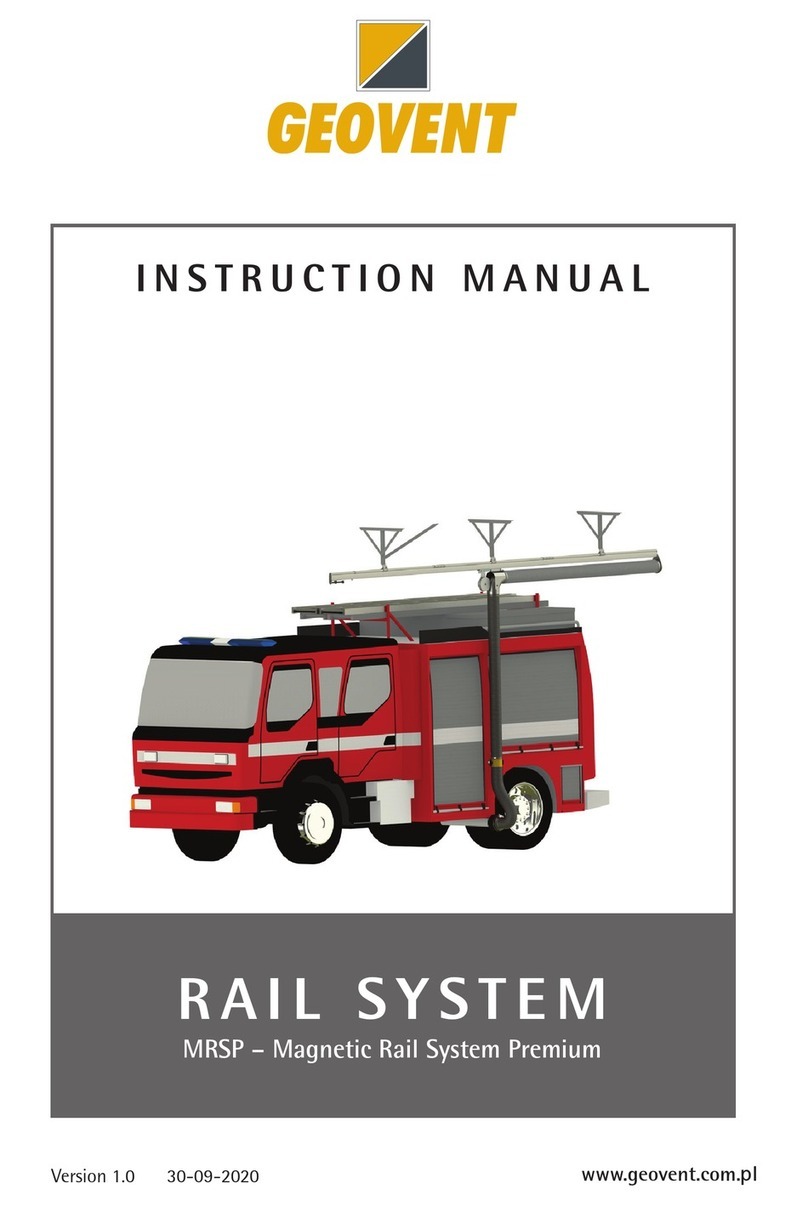
Geovent
Geovent Magnetic Rail System Premium User manual

Geovent
Geovent GEOFILTER DUST User manual
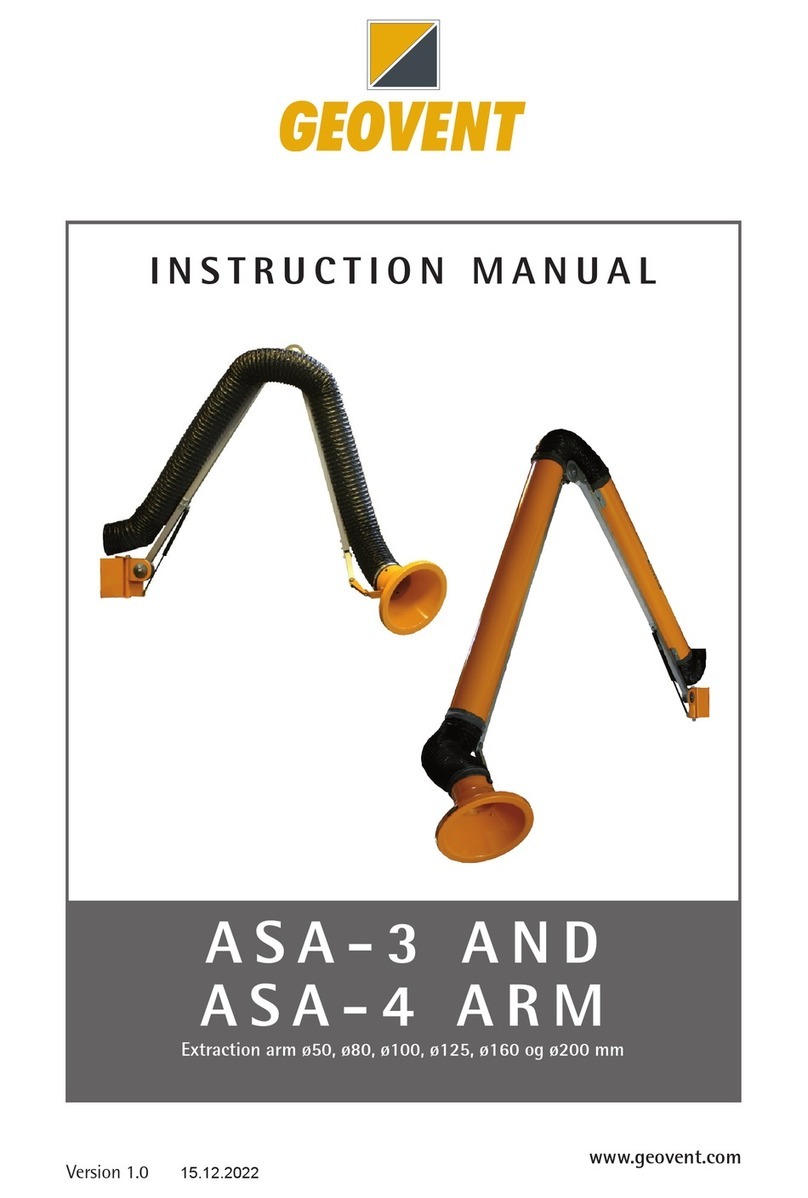
Geovent
Geovent ASA-3 Series User manual

Geovent
Geovent COMPACT arm User manual
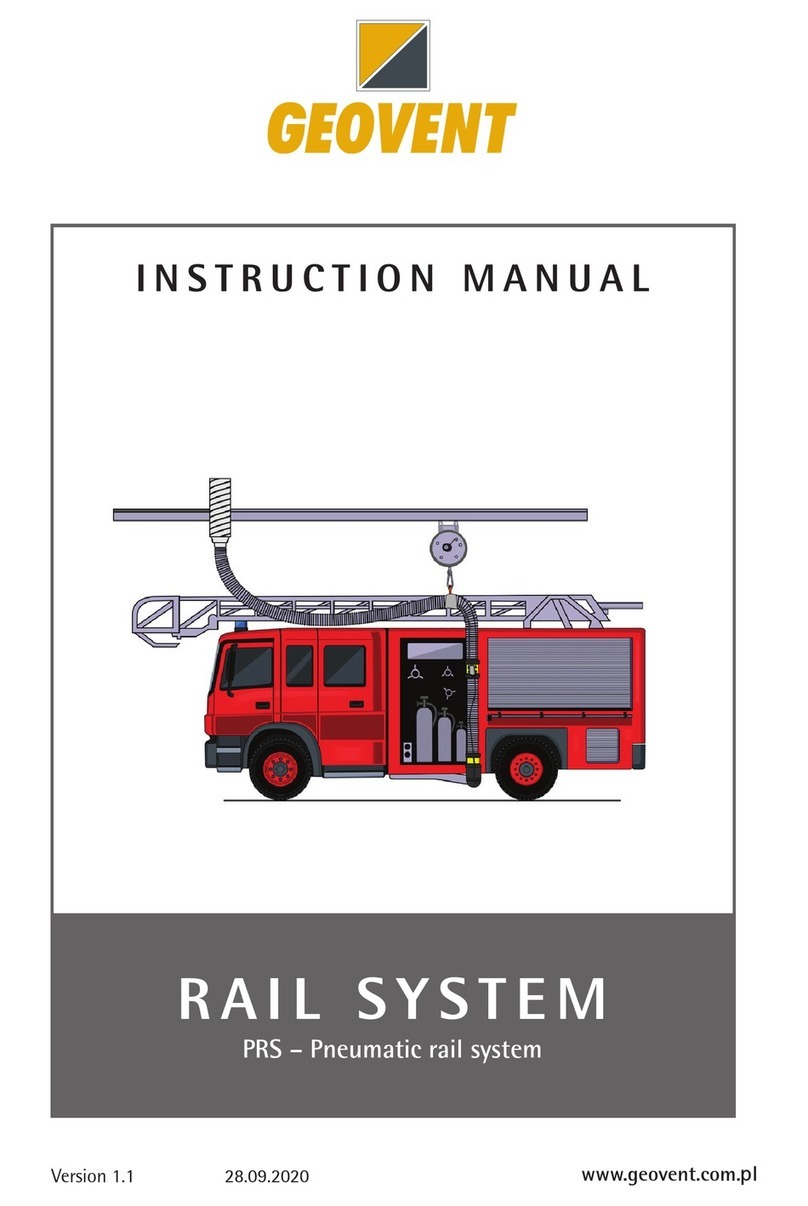
Geovent
Geovent PRS User manual
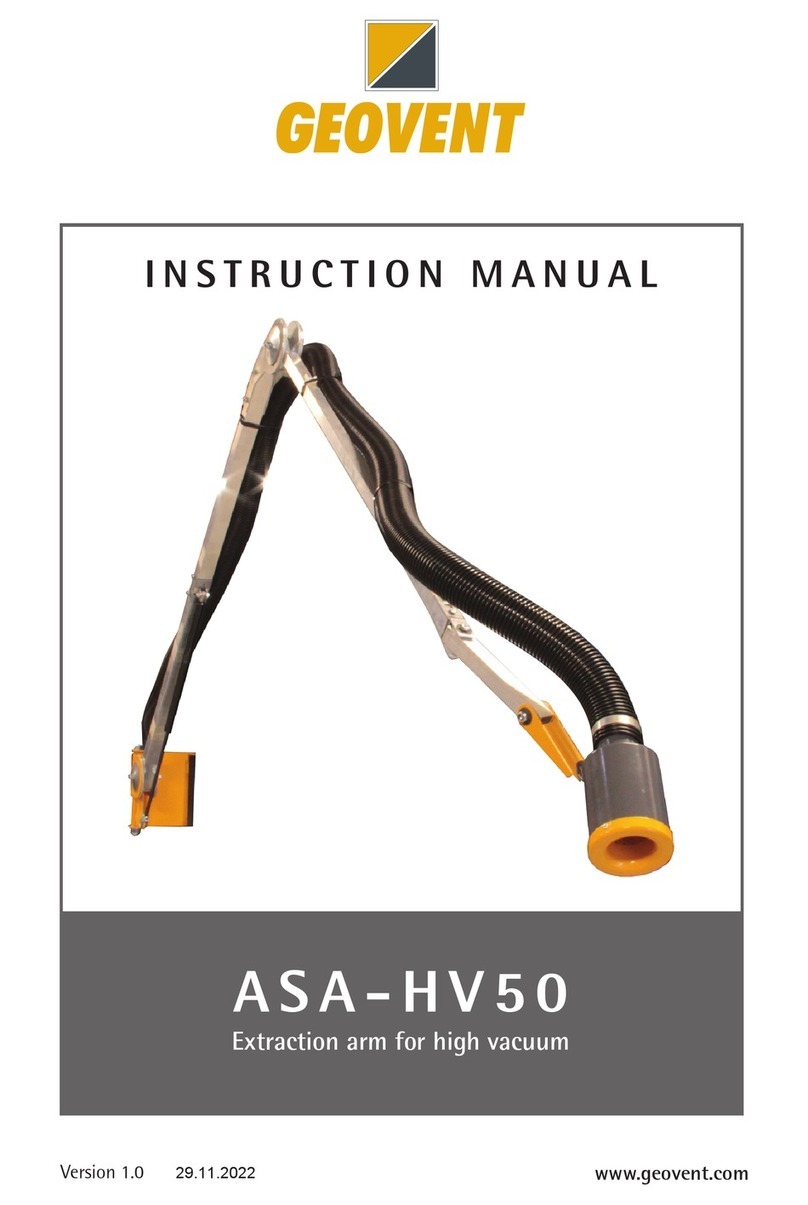
Geovent
Geovent ASA-HV50 User manual

Geovent
Geovent 25 User manual
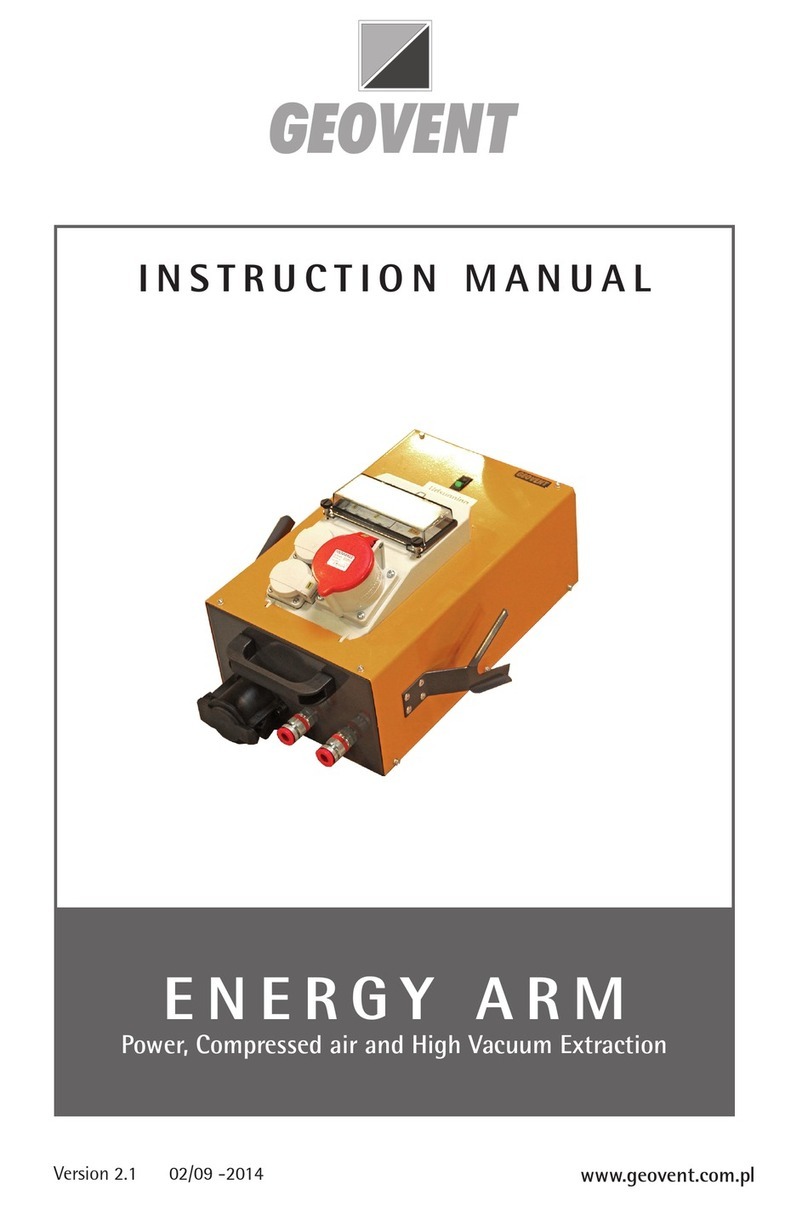
Geovent
Geovent ENERGY ARM User manual
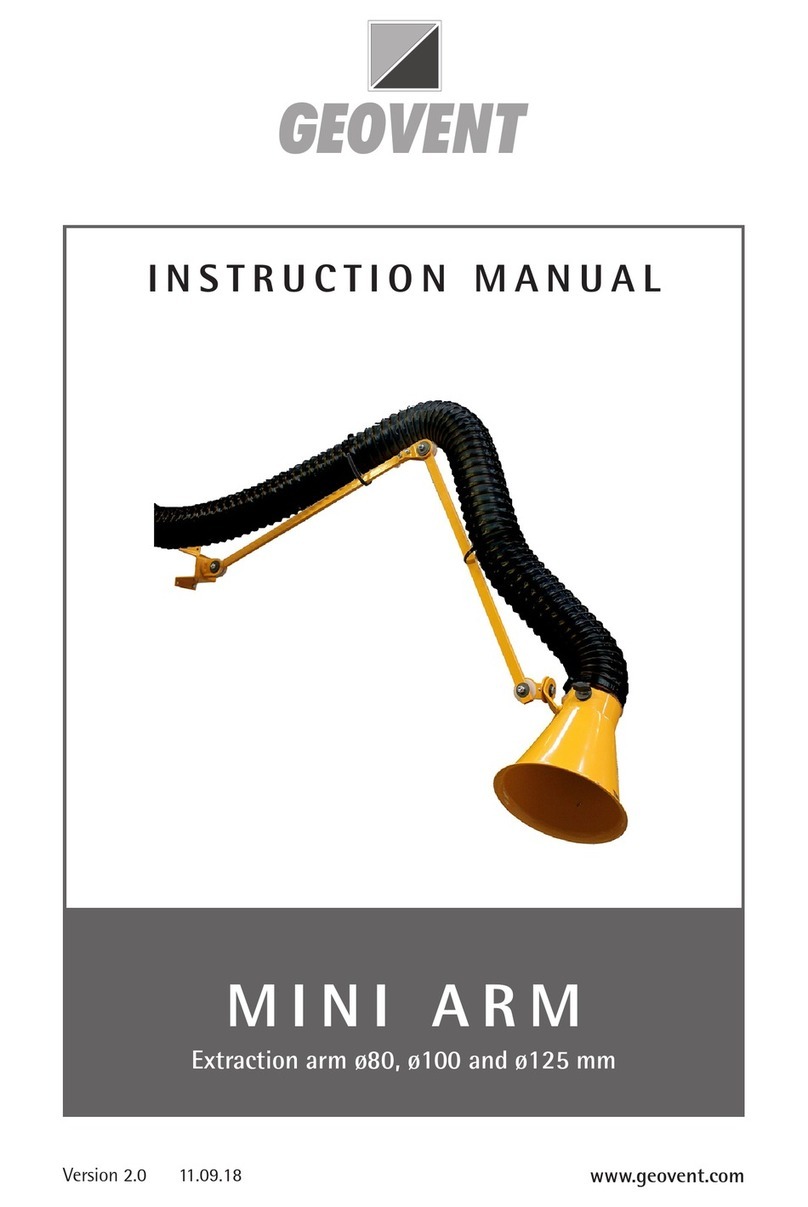
Geovent
Geovent MINI ARM User manual

















